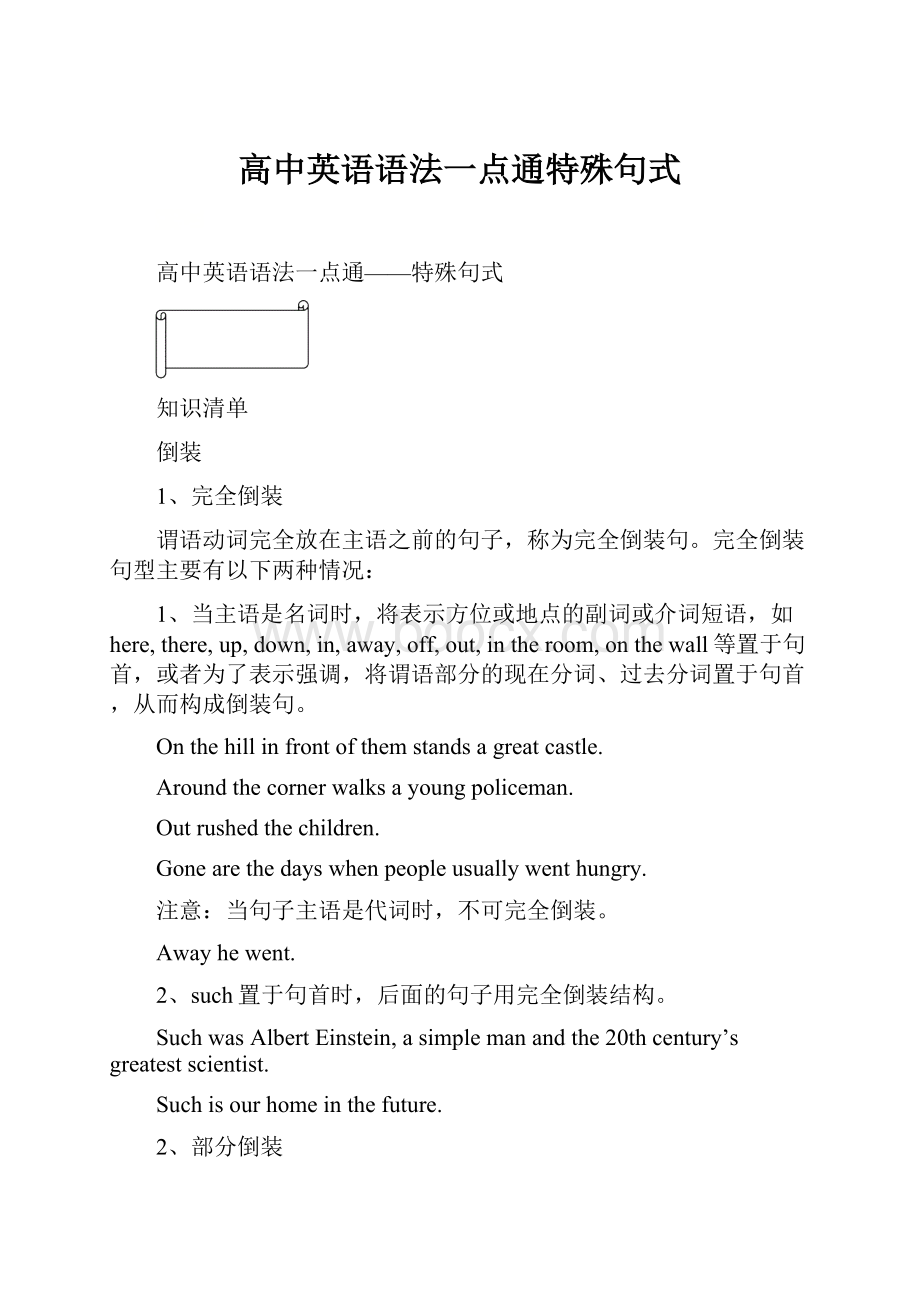高中英语语法一点通特殊句式.docx
《高中英语语法一点通特殊句式.docx》由会员分享,可在线阅读,更多相关《高中英语语法一点通特殊句式.docx(18页珍藏版)》请在冰豆网上搜索。

高中英语语法一点通特殊句式
高中英语语法一点通——特殊句式
知识清单
倒装
1、完全倒装
谓语动词完全放在主语之前的句子,称为完全倒装句。
完全倒装句型主要有以下两种情况:
1、当主语是名词时,将表示方位或地点的副词或介词短语,如here,there,up,down,in,away,off,out,intheroom,onthewall等置于句首,或者为了表示强调,将谓语部分的现在分词、过去分词置于句首,从而构成倒装句。
Onthehillinfrontofthemstandsagreatcastle.
Aroundthecornerwalksayoungpoliceman.
Outrushedthechildren.
Gonearethedayswhenpeopleusuallywenthungry.
注意:
当句子主语是代词时,不可完全倒装。
Awayhewent.
2、such置于句首时,后面的句子用完全倒装结构。
SuchwasAlbertEinstein,asimplemanandthe20thcentury’sgreatestscientist.
Suchisourhomeinthefuture.
2、部分倒装
只把谓语的一部分(多为助动词和情态动词)置于主语之前的句子,叫作部分倒装句。
部分倒装句主要有以下几种:
1、only修饰副词、介词短语或者状语从句,作状语,且放在句首时。
OnlyinthiswaycanwelearnEnglishwell.
OnlythendidIunderstandwhatshemeant.
特别提醒:
1only修饰状语从句时,从句不倒装,主句用部分倒装结构。
Onlyafteryouhavereachedeighteencanyoujointhearmy.
2only修饰主语时,句子不用倒装。
Onlyhecananswerthequestion.
2、否定副词never,nor,hardly,little,seldom,scarcely,rarely以及表示否定意义的介词短语atnotime,undernocircumstance,innocase,bynomeans,onnocondition等置于句首时。
NeverbeforehaveIseensuchamovingfilm.
HardlydoIthinkitpossibletofinishthejobbeforedark.
3、副词so后接形容词或副词位于句首时,构成句型“So+adj./adv.+that...”。
Somuchdidtheyeatthattheycouldnotmoveforthenexthour.
SoclearlydoeshespeakEnglishthathecanalwaysmakehimselfunderstood.
4、notonly...butalso...“不仅……而且……”,notonly谓语句首时,后面的分句用部分倒装结构,但but(also)引导的句子用正常语序。
Notonlywillhelpbegiventopeopletofindjobs,butalsomedicaltreatmentwillbeprovidedforpeoplewhoneedit.
5、notuntil...“直到……才……”位于句首时,主句用倒装结构,从句不倒装。
Notuntilhereturneddidwehavesupper.
6、表示前面所说的情况也适合于后者时,用“so/neither/nor+助动词/情态动词/be动词+主语”这样的倒装句式。
so用于肯定句中,neither/nor用于否定句。
HecansingEnglishsongs,andsocanI.
Hedidn'tseethefilm,andneitherdidI.
Shelikesmusic,andsodoI.
Shehasn'treadit,andnorhaveI.
3、形式倒装
形式上的倒装在语法上称为前置,特点是把强调的内容提至句首,主谓不倒装,常见的句型主要有以下几种:
1、“the+比较级,the+比较级”意为“越……,越……”。
Themoreexerciseyoutake,thehealthieryouare.
Theharderyouwork,thegreaterprogressyouwillmake.
2、whatever+n.引导让步状语从句,意为“无论什么……”,however+adj./adv.引导让步状语从句,意为“无论多么……”。
Whatevernonsensethenewspapersprint,somepeoplealwaysbelieveit.
Howeverdifficulttheproblemmaybe,wemustworkitoutthisevening.
3、as和though引导的让步状语从句,采用倒装形式。
Tiredas/thoughhewas,hestillwentonwithhiswork.
Tryas/thoughyoumight,youcan’tkeepthelosttime.
Muchas/thoughhelikesthebike,hedoesn’twanttobuyit.
强调
1、强调句
1、强调句的陈述句形式为:
Itis/was+被强调部分+that/who+句子剩余部分。
当强调人时,可用who来代替that。
被强调部分可以是单词、短语或者从句,但是去掉Itis/was...that...之后,句子结构必须完整,常被强调的句子成分有:
主语、宾语和状语。
ItwasAnnPeterthat/whorushedhertoanearbyhospitallastnight.
Itwasherthat/whoAnnPeterrushedtoanearbyhospitallastnight.
ItwaslastnightthatAnnPeterrushedtoanearbyhospital.
Itwaswhathesaidthatmadeherangry.
Itwaswhentherainstoppedthattheycontinuedworking.
2、强调句型的一般疑问句:
Is/Wasit+被强调部分+that/who+其它句子成分?
Isitthefamouswriterandhisworksthathavearousedgreatinterestamongthestudents?
Wasitinthestationthatyoumeteachotheryesterday?
3、强调句型的特殊疑问句:
特殊疑问词+is/was+it+that+其它成分?
Whowasitthatbrokethewindow?
Whenandwherewasitthatyouwereborn?
Whywasitthatyoukeptsilentatthemeeting?
4、有时候可用Itmightbe...that/who...或者Itmusthavebeen...that/who...句型表示强调。
Itmightbehisfatherthat/whoyou’rethinkingof?
Itmusthavebeenhisbrotherthat/whoyousaw?
5、not...until...句型的强调句式为:
Itis/wasnotuntil...+that+其它成分。
Itwasnotuntiltheearlyyearsofthe19thcenturythanmanknewwhatheatwas.
ItwasnotuntilshetookoffherdarkglassesthatIrealizedshewasthefamousfilmstar.
6、强调句与其它句型的混用
1强调句用于宾语从句中
Hetoldmethatitwasbecausehewaslateforclassthathewaspunished.
Ireallycan’trememberwhereitwasthatIfirstmettheman.
2强调句中被强调的名词后常接一个定语从句来修饰。
WasitBill,whoplaysfootballwell,thathelpedtheblindmancrosstheroad?
Itwasintheschool,whereIoncestudied,thatweheldaparty.
Wasitinthehouse,whichwevisitedlastyear,thatthemurderhappened?
3强调句用于感叹句中。
Whatasillymistakeitisthatyouhavemade!
2、对谓语动词的强调
强调句型不能用来强调谓语动词,如果需要强调谓语动词,要用助动词do,does或did。
Docomethisevening.
Hedidwritetoyoulastweek.
Tomdoesstudyhardnow.
反意疑问句
1、陈述句含有must/may(might)的反意疑问句
1、当must作“必须”讲时,反意疑问句用needn't;当含有mustn't(不允许、禁止)时,反意疑问句用must。
Youmustgonow,needn’tyou?
Youmustn’tsmokehere,mustyou?
2、当must/may(might)表示推测时,可首先将句子改为“Iamsure/guess+that从句”,反意疑问句根据besure/guess后的宾语从句的谓语动词形式来确定。
Youmust/may(might)behungrynow,?
→Iamsure/guessthatyouarehungrynow,aren’tyou?
→Youmust/may(might)behungrynow,aren’tyou?
Youmusthaveheardaboutit,?
→Iamsurethatyoumusthaveheardaboutit,haven’tyou?
→Youmusthaveheardaboutit,haven’tyou?
Youmusthavewatchedthatfootballmatchlastnight,?
→Iamsurethatyouwatchedthatfootballmatchlastnight,didn’tyou?
→Youmusthavewatchedthatfootballmatchlastnight,didn’tyou?
2、陈述句含有usedto的反意疑问句
陈述句含有usedto,表示“过去常常”,反意疑问句用usedn't或didn't均可。
Youusedtosleepwiththewindowsopen,usedn’t/didn’tyou?
3、陈述句含有否定词或者半否定词的反意疑问句
当陈述句部分带有seldom,hardly,scarcely,never,few,little,nothing,nobody等否定或者半否定词时,反意疑问句用肯定形式。
Hecouldhardlywalkwithoutastick,couldhe?
4、陈述句含有否定前缀构成的词
Tomdislikesplayingtennis,doesn’the?
It’sunfair,isn’tit?
5、陈述句含有宾语从句的反意疑问句
1、当陈述句含有宾语从句时,反意疑问句的主语和助动词常和主句保持一致。
Hesaidthathewouldcometomybirthdayparty,didn’the?
Tomdoesn’tbelieveJanewillsucceed,doeshe?
2、当陈述句主句的谓语动词是think,believe,suppose,guess,expect,imagine,besure等,且主句主语为第一人称时,反意疑问句的主语和时态与宾语从句的主语和时态保持一致。
Idon’tbelievehewillsucceed,willhe?
6、祈使句的反意疑问句
祈使句后的反意疑问句,常见的结构形式有:
肯定祈使句,will/won’tyou?
否定祈使句,willyou?
Let’s...,shallwe?
Letus...,willyou?
Openthedoor,will/won’tyou?
Let’sgooutforawalk,shallwe?
Letusgohomenow,willyou?
7、反意疑问句的回答原则
不管陈述句是肯定还是否定,回答时只根据事实情况来确定,如果事实是肯定的,就用yes回答,如果事实是否定的,就用no回答。
也就是说无需考虑句子原本是前肯后否还是前否后肯。
--Youaren’tateacher,areyou?
--Yes,Iam.(我是老师)
--No,Iamnot.(我不是老师)
祈使句
1、肯定式、否定式和强调式
Keepsilentinthereadingroom.
Don’tbesosure.
Nevercomelate.
Docomeontimethisevening.
Dobecareful.
2、带主语的祈使句
Tom,watertheflowers.
Bequiet,everybody.
感叹句
1、基本形式
What+(a/an)+形容词+名词+主语+谓语!
How+形容词+a/an+单数可数名词+主语+谓语!
How+形容词/副词+主语+谓语!
Whatacleverboyheis!
=Howclevertheboyis!
Whatsweetwateritis!
Howfastheisrunning!
2、省略式的感叹句
1、how直接修饰谓语动词:
How+主语+谓语!
How(much)weloveourmotherland!
2、省略形容词,what直接修饰名词。
Whatadaywehave!
3、其它形式的感叹句
Howcanyoubesosilly!
省略
1、定语从句中的省略
限制性定语从句中作宾语的关系代词that,which,whom常可以省略,定语从句的先行词是way(关系词在从句中作状语),关系词可省略。
Thisisthebook(that)Iboughtyesterday.
That’snottherightwaywegetonwithlittlekids.
2、状语从句中的省略
1、当状语从句的主语和主句的主语一致,且从句中含有be动词时,可以省略状语从句中的主语和be动词,这时从句中可出现如下结构:
1连词(when,if,though等)+形容词
Workhardwhen(youare)young,oryou’llregret.
2连词(once,asif,while等)+介词短语
Helookedeverywhereasif(hewas)insearchofsomething.
3连词(when,while,though等)+现在分词
While(Iwas)walkingalongthestreet,Iheardmynamecalled.
连词(when,if,evenif,unless,once,until,than,as等)+过去分词
Theexhibitionismoreinterestingthan(itwas)expected.
连词(asif,asthough)+不定式
heopenedhislipsasif(hewere)tospeak.
2、当从句中的主语时it,谓语动词中由含有be动词时,可以将it和be动词一起省略。
此时构成“连词(if,unless,when,whenever等)+形容词”。
Unless(itis)necessary,you’dbetternotrefertothedictionary.
Getupearlytomorrow.Ifnot(=Ifyoudon’tgetupearly),youwillmissthefirstbus.
Hemaynotbeathomethen.Ifso(Ifheisnotathome),leavehimanote.
3、不定式的省略
1、单独使用不定式符号to,代替动词不定式中被省略的部分,常用在beafraid,expect,forget,hope,intend,hope,like,love,mean,seem,refuse,wish,want等后面。
Iaskedhimtoseethefilm,buthedidn’twantto.
2、不定式符号to用在have,need,ought,begoing,used等后面。
Ididn’twanttogothere,butIhadto.
3、不定式符号to用在某些形容词,如glad,happy,pleased,delighted等后面。
--Willyoujoininthegame?
--I’dbegladto.
4、否定形式的不定式省略用notto。
--ShallIgoinsteadofhim?
--Ipreferyounotto.
5、如果不定式中含有be,have,havebeen,通常保留be,have和havebeen。
--Areyouasailor?
--No,butIusedtobe.
--Hehasn’tfinishedyet.
--Well,heoughttohave.
Therebe句型
1、基本结构
1、therebe句型在英语中表示“什么地方存在某物”,be动词的单复数和后面的名词保持一致,如果有两个或者两个以上名词,谓语动词be要遵循就近一致原则。
Thereisatalltreeinfrontoftheclassroom.
Thereisapen,twobooks,andmanypencilsonthedesk.
2、特殊形式
1、therebe结构有不同的时态形式,而且可以和各种助动词、情态动词连用。
Therewasameetinginourschoolyesterday.
TherewillbeanewfilmshownonSunday.
Therehavebeenmanygreatchangesinourcountrysincethen.
Therecan’tbeanymistakeinhispassage.
2、therebe结构中的谓语动词be有时可用seemtobe,happentobe,belikelytobe,usedtobe或半系动词remain,stand,lie,go,exist,follow,live,come,occur等替换。
Thereislikelytobesomethingwrongwithhiscomputer.
Onceuponatimetherelivedanoldmonkinthetemple.
3、therebe句型的非谓语形式
Ihaveneverimaginedoftherebeingapictureonthewall.
Iexpecttheretobemanychancesforhimtogetajob.
Therebeingnoenoughtimeleft,wehavetohurryup.
Therehavingbeennowaterfor2days,thetravelerswereallthirsty.
主谓一致
一、并列主语的主谓一致
1、两个单数名词或者不可数名词用and连接,表示两个不同的概念时,谓语动词用复数形式。
TomandJackareclosefriends.
Steamandicearedifferentformsofwater.
2、两个单数名词用and连接,第二个名词前不加冠词,表示同一个人、物或者概念,谓语动词仍用单数形式。
Thesingeranddancerhasbeeninvitedtoattendoureveningparty.
3、被every,each,manya,no等限定的单数名词由and连接作主语时,谓语动词仍用单数形式。
EachboyandeachgirlinourclasshasanEnglishname.
Manyateacherandmanyastudenthasseenthefilm.
4、由or,nor,either...or...,neither...nor...,notonly...but(also)连接的并列主语,通常根据就近一致原则,谓语动词的单复数要和与它临近的主语的数保持一致。
Oneortwofriendsare